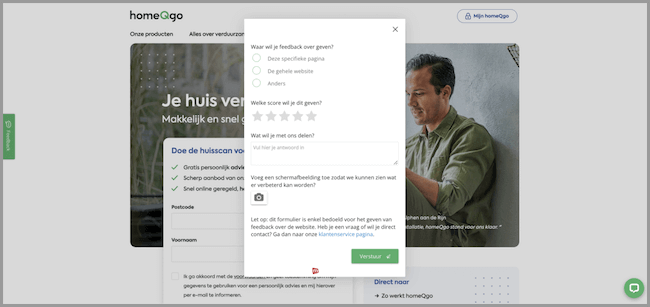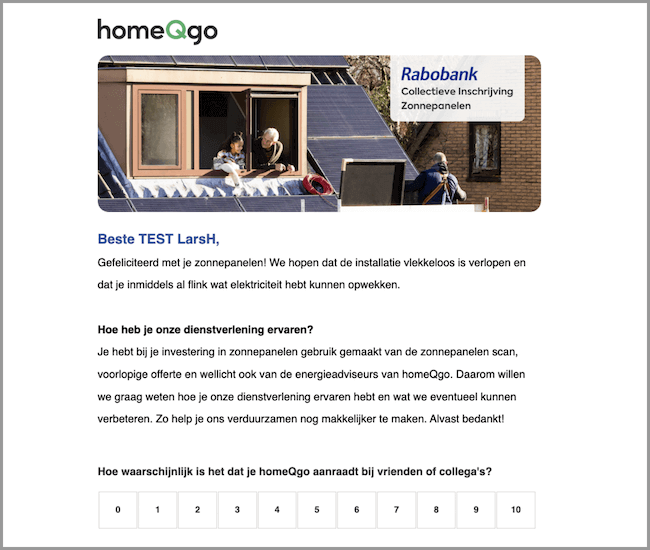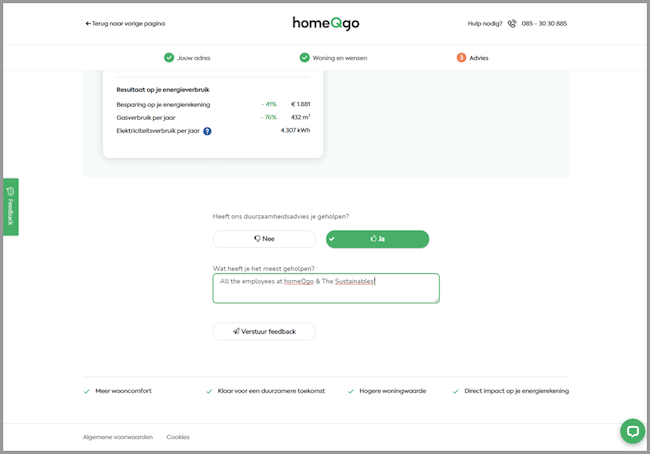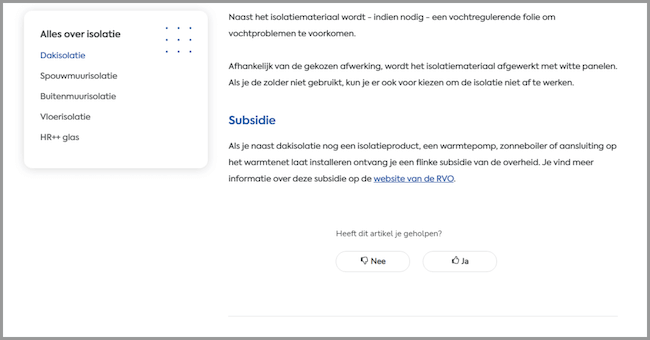Sustainability is a hot topic nowadays. Consumers and organisations alike are making more of an effort to become more sustainable, and that even includes making their homes more sustainable. And that’s good news for companies like homeQgo. In a previous customer story with homeQgo we shared a bit about homeQgo’s perspective on the booming market, which challenges this explosive growth entails and how they deal with. To improve the online customer experience and make the online journey even smoother, homeQgo has now largely automated the process of collecting customer feedback. The result? A more efficient way of working and a real chance to reap the benefits of customer feedback.
Customer feedback to stay ahead of the competition
homeQgo has been collecting feedback for quite a while, in order to properly map out the customer journey. They offer customers the opportunity to leave a comment or review via a feedback form. In a previous article, we shared insights gained from an interview with Lars Harmsen, Head of User Experience, about homeQgo’s customer feedback program. A lot has changed in the market since and which has created a number of new challenges for homeQgo which is why we decided to touch base again and get a pulse on how things are going.
Not surprisingly, sustainability is still ‘hot’ and therefore, competition is growing and that is why it is important for homeQgo to maintain their place in the market. So what’s their formula for success?

Example of website feedback on the homeQgo website.
homeQgo collects website and email feedback
homeQgo started actively collecting feedback last year to map out its online customer journey(s). In order to determine what works, what is important and what customers want, homeQgo collects feedback via both the website and within email campaigns.
homeQgo’s Lars knows how important feedback is, but he’s got a lot of other tasks on his plate. That’s why he and his team decided to automate the feedback collection process. This way the feedback continues to come in consistently, the team can analyse the feedback and the correct follow-up can take place. The customer feedback loop remains an ongoing process.
“By properly organising the feedback loop and automating feedback, you have more time for other things.

Lars Harmsen, Head of User Experience at homeQgo
How can you automate customer feedback?
We asked Lars how he set up and automated the various customer feedback flows. “In the past, collecting feedback was done manually,” says Lars. “A colleague would make an export of the email addresses and the UX team would send an email with a survey. Now we have our feedback software Mopinion linked to the CRM.
If someone’s customer status changes, that person will automatically receive an email with an embedded NPS survey. The response rate of this survey is high. In fact about 18% of the recipients actually respond. By automating and integrating feedback, you can be sure that the right people are asked the right questions.”
The NPS flow is also automated and the scores collected with Mopinion are sent directly to Google Analytics. This allows the team to perform GA analyses on promoters, passives, and detractors, and add the NPS score to internal reports in a fully automated manner using Google Sheets and Data Studio. And by combining the different data sources, the team was able to extract new insights.
Lars explains: “We analyse the surveys extensively and supplement with as much relevant data as possible, and then the results are shared internally.”

Example of an NPS survey in a homeQgo email
Examples of feedback flows at homeQgo
homeQgo has an embedded NPS survey in their emails. In other words, users don’t have to click on a button which takes them to a separate page with a survey.
“As an email recipient, you can leave your feedback directly in the email, which leads to a much higher response rate.”
If you want to add an extra comment, you can of course do that too. If you have answered the NPS question, you can explain your answer thanks to a follow-up question. And because people seem to complete that first step quite easily, we see that they’re often also willing to provide an explanation as well,” says Lars.
homeQgo also has a CES form located on the advice page. And the feedback shows that the advice page is easy to find.
“We also ask if there is anything we can improve upon,” says Lars. “At the end of the customer journey, our customers see a CES feedback form. Many journeys end at homeQgo in requesting a quote. Customers first go through a few steps before they can request a quote. They then receive a PDF of the quotation for a sustainability initiative. We also placed a CES form here, asking whether it was difficult to request the quote. We receive a lot of positive responses to this which is encouraging for all of our colleagues who work very hard to make our advice and quotations as optimal as possible,” shares Lars.

Feedback form on the advice page
Customer feedback contributes to efficiency and growth
The demand for solar panels has gone up tremendously this past year which has pushed customers to request quotes from various parties. This has created a lot of competitiveness in the market. Some of the customers who request a quote through homeQgo – in some cases – still end up choosing another provider.
“We therefore proactively ask customers who have been “open” for a while whether they are still interested, or whether they want to cancel the request for quotation because they have been helped elsewhere. By actively requesting this information, we keep waiting times shorter,” explains Lars. It would be a shame if people forgot to unsubscribe which would create an unnecessarily long waiting list.
Alternatively if customers terminate their application, homeQgo wants to know why…
“For example, we regularly read that someone has chosen a local installation service. Based on that feedback, the team decided to perform a search for local installation services so as to cater to those customers.”

Benefits of automating customer feedback
Lars and his team at homeQgo have noticed a positive difference since automating their feedback flows and seen a big improvement in efficiency.
With the hectic pace of a start-up in a booming market, automating feedback ensures that the feedback is no longer left behind or forgotten. Feedback surveys are now consistently deployed and therefore feedback is continuously received. At the same time, this automation leaves time to convert the feedback into actions.
More than half of Lars’ colleagues use the feedback results for their daily work. From the consultant and developer to the buyer, feedback plays a major role in making decisions at homeQgo.
homeQgo is customer-oriented and data-driven.
Our feedback never ends up in a corner.Lars Harmsen, Head of User Experience at homeQgo

Example of content feedback that comes in via Slack (in Dutch only)
The customer feedback loop is never finished
And homeQgo knows that too. The feedback flows at homeQgo are not finished yet. In the coming period, Lars and his team will ensure that feedback is also deployed on other specific pages.
The organisation is well aware that in these times it is important to properly inform customers and, above all, to listen carefully to your customers.
Ready to see Mopinion in action?
Want to learn more about Mopinion’s all-in-1 user feedback platform? Don’t be shy and take our software for a spin! Do you prefer it a bit more personal? Just book a demo. One of our feedback pro’s will guide you through the software and answer any questions you may have.







